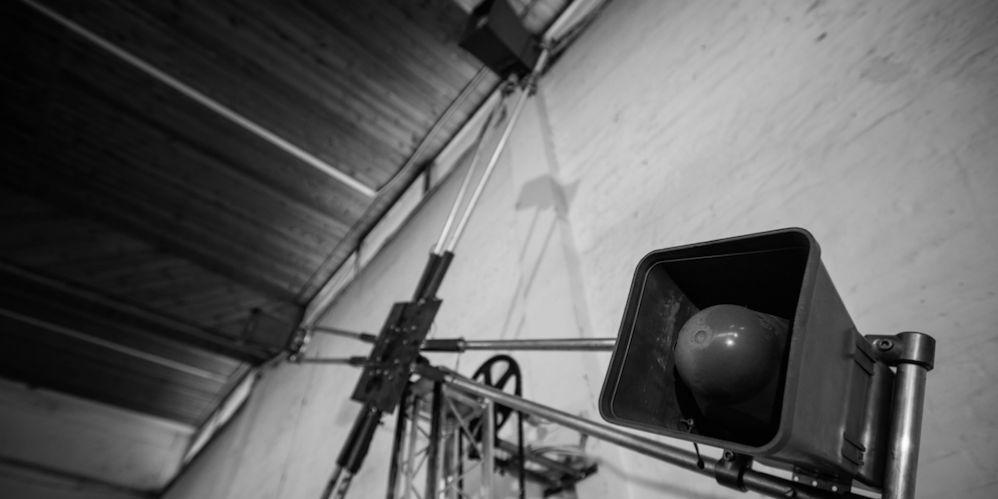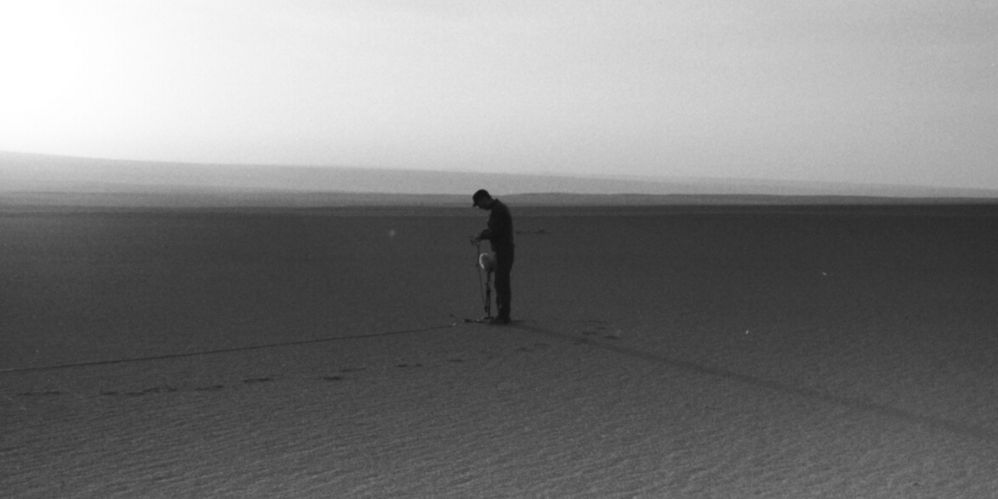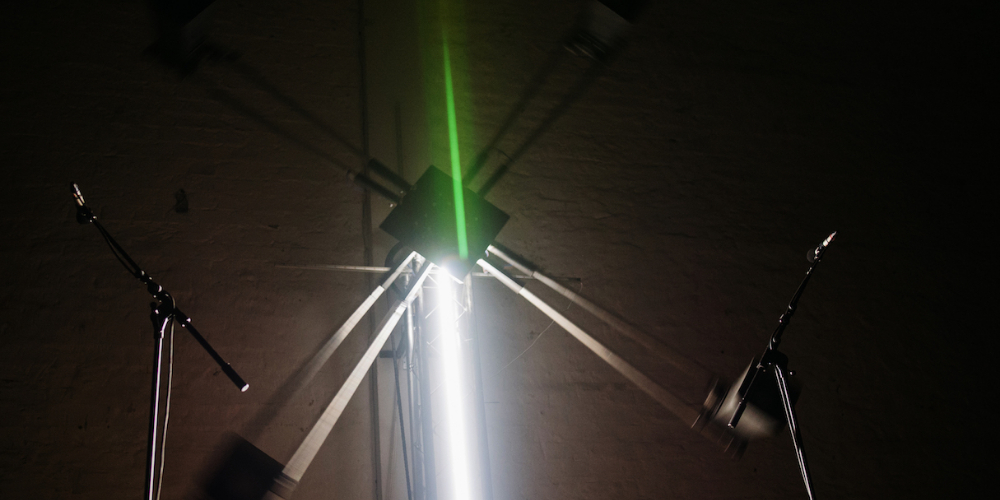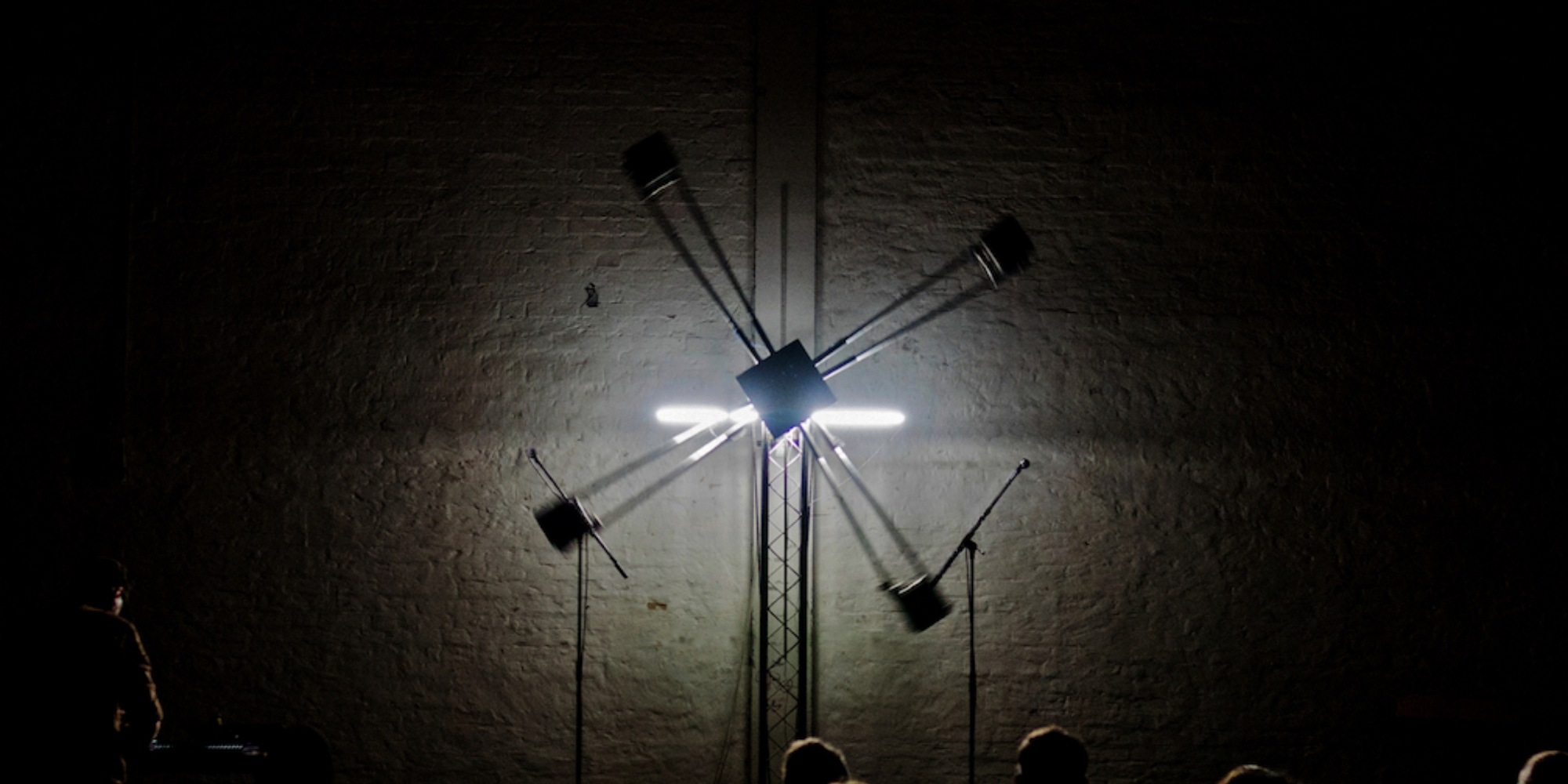With the kinetic sound sculpture TORSO #1, Kutin created an impressive installation that not only penetrates deep into the consciousness of the visitors but can also have a threatening, almost aggressive effect. The setup is easy to explain: four speakers on four rotors turn with varying speed on an axis over two meters long, creating acoustic signals and feedback. From time to time, subtle voices can be heard. The atmosphere it produces is hypnotic and somewhat eerie. We spoke with Peter Kutin to learn more.
TORSO deals with speed – acceleration, slowing down, listening position. What interests you about that? What did you want to find out or communicate?
Peter Kutin: With TORSO, I consciously focus on psychological and phenomenological aspects. That happens not only at the level of sound. Relationships are created between what you see and what you hear – or what you think you hear. In terms of composition, I also deliberately work with psychoacoustic means, among other things.
In addition to the actual manipulation of the sound through rotation and acceleration, the resulting image makes a strong impression on individual perception. Because the speed can be observed and comprehended as a circular motion, an idiosyncratic link with the auditory perception is produced. Something is created that may not even be there. During testing I was always very interested in those moments, where something tipped inside me… it’s hard to describe or put into words, but it’s a moment when the interplay of the components sound, motion, light and object opened up a space where I no longer understood exactly what was happening and how, but I felt it was right. The feeling that something is happening that is calling me and not letting go. It was important to me to keep the basic parameters as simple and clear as possible. Meaning the listeners recognize that there are four speakers rotating here and the speed affects the overall condition.
Then I wanted to write or develop appropriate musical situations for this system. The light concept was added at a later stage and led to further intensification. However, the premise was that TORSO should also function purely as sound, so the light would not be used as a conjuring trick to cover for musical flaws. As a whole, TORSO creates a space strongly influenced and structured by a strange and fundamentally simple machine. I don’t want listeners to get drawn into taking it apart analytically – I want their senses to be seduced. They should find it physically demanding and sometimes perhaps overwhelming without intellectually scrutinizing it. In a time where every piece of information is available at any time, I see situations like this as a form of freedom. In short, the work should open up individual realms of experience. It’s important to me that there is also a subcutaneous feeling of insecurity, that you’re a bit challenged to listen instinctively too, because you’re wary – no matter how soothing the sound may be at the moment. I like it when the sense of hearing gets back to this primal instinct and people become inclined to behave animalistically while listening. I love watching cats or deer listening – when people react with an approach that is even just similar to that at concerts or sound installations, it makes me chuckle, I think it’s good.
Describe for us how a project like this comes about. How does it start out? How does it become more specific? Which influences play into it? How long does the whole process last?
Peter Kutin: The initial spark for the project were these special speakers. I found about 30 of them in the backyard of an abandoned train station. They were just sitting out there, in a desolate condition, covered in dirt and swamped with rainwater. Nobody seemed to miss them, so I took them away and partially repaired them. They’re wonderfully constructed 100 volt speakers, the kind used at old Austrian Railways stations. It’s not high-end, nor is it designed for playing music. The functional idea behind these speakers is to make speech understandable at the highest possible volume. Musical productions don’t have much impact over these speakers.
Because they’re so strong and also because of their fascinating optics, I wanted to use them for a project with moving speakers. However, you have to find and develop suitable sounds so that the sounds take on an exciting form and a certain character. The frequency technology of these speakers is very limited and they also have a very high distortion coefficient (klirr-factor) depending on the frequency, i.e. the speakers distort the sound at certain pitches. But it’s with these flaws that the artistic work can happen. It also gives TORSO a very distinctive character.
As material, I first used just one voice (soprano) and listened to how the speakers worked. Then I started to abstract the voice until the speakers reacted more strongly or in a way that was exciting to my ears. Johanna Sophia Baader is the soprano. It was very rewarding to work with such a precise voice. The different total sounds or clusters that we generated together from her voice now combine with two simple feedback loops to form a kind of basis for entire composition.
But let’s go back to the origin story because there’s a really nice anecdote here. The starting point was, as I said, these speakers. While I was living on a scholarship grant in the southern no-man’s-land of Styria for an extended period, I had an extraordinary neighbor, a hard-headed artistic carpenter who is known for having made the largest klopotec in the world by himself. Some of my artist colleagues in the area and I were organizing a multidisciplinary festival at one point and I wanted to build a kind of klopotec for it that would have speakers on its arms. He, of course, thought I was joking, but quickly realized how serious it was for my colleagues and me. In the end, he selected a tree trunk for the object and felled it himself. It was a wonderfully bizarre cooperation between two stubborn people.
When we put up this so-called “antifascist klopotec,” it quickly became clear how the rotation was affecting the sound. The potential for further musical development was obvious even then. Above all, I found the relationship that arose between the optical and acoustic components very exciting – object, rotation speed, sound… this simple yet complex interplay gave me the idea for TORSO.
In cooperation with Patrik Lechner and Mathias Lenz, I’m currently designing a new version of TORSO. It’s a composition commissioned by SAT (Societe des Arts et Technologies) Montreal and will premiere in summer 2020. For that one we want to construct speakers with even more targeted coordination with the rotation principle, which will then create a higher sound pressure. The concert will then take place in a domed room with an ambisonic surround system and video projection that fills the dome – the Satosphere, a unique, multifunctional space for audiovisual concerts. We are really excited!

Credit: David Visnjic
Tell us a little about the “violence of speed,” as Paul Virilio puts it. He was a major influence on your work – what fascinates you about his ideas? What do you get out of them for your work?
Peter Kutin: Here I have to say in advance that I’m no expert on Virilio. During my work on TORSO I got to grips with some of his ideas, which was logical in the context and also very inspiring. So individual trains of thought or phrases from Virilio became a kind of springboard for composition or atmosphere. For example, when he speaks of the “racing standstill,” the “disappearance of perception,” or the “dissolution of space,” that corresponds to what I’m trying to create with TORSO in a musical-sculptural context. Experts in philosophy and especially physics tend to take a more critical view of Virilio, perhaps also because he moves among several fields rather than being “only” an expert in one subject. He was certainly a pioneer and visionary in the field of recognizing how speed influences or manipulates our perception and existence.
But I’d known for a long time that I wanted to work with acceleration and movement of sound sources – that train of thought owes much more to musical experiences and influences from composers or artists in various disciplines than to Virilio’s texts. It was and still is always very important to me that apart from content, a work also functions purely through the sound or through the sensory level and opens up a space of experience. By which I mean, it can be experienced even without any special background knowledge.

Credit: U.M.Z.
Is TORSO the “apt noise for our disturbed existence”?
Peter Kutin: One quality of TORSO is that you are challenged by an optically spare, technically simple machine. This machine has something archaic in it – the klopotec, this primitive form of a windmill. A kind of friction is created, an anachronism. Then there is the fact that a human, bodily presence is lacking. So the tension arises purely between the sculpture and the visitor.
The interplay of light, sound, and rotation takes up the entire space, with the circular motion always forming the center. Virilio in particular likes to use the idea of turning in a circle as a metaphor for the cultural state of postmodernity. In the case of TORSO, everyone can interpret that metaphorically for themselves. But I think the work opens up a lot of things that I can’t even explain myself. Complexity of Simplicity. Or it’s just the Zeitgeist that’s in it. I think because there’s no interpreter or body directly present here that acts or performs, you get this feeling of being exposed to technology. In many very exciting scenes, physical presence of artists is rejected – the state of being surrendered to something becomes very important for the recipient here. Like at free parties, where the DJs are behind massive towers and walls made of boxes, so you can’t see them, or at a rave, where fog and strobe lights swallow everything and you’re just being subjected to sound and light. TORSO is part of that kind of tradition, even though the musical parameters are completely different.

Credit: Peter Kutin
In your video, the live performance lasts about 10 minutes. Is that by chance? Could it also last for hours?
Peter Kutin: The video is only an excerpt from the first setting of TORSO, which took place at a live concert and lasted about 35 minutes. Since you can’t represent or capture the quality of the work 100 percent in a video, it just doesn’t make sense to make it available at full-length. To make an installation version like the one being implemented for the Ars Electronica Festival, you have to think differently again. Especially if people can move around more in the space than they generally do at a concert. Changing location can massively change perception of TORSO, which means you can give more time to the individual conditions and take the movements of visitors into account when planning the composition. But the new piece will only come into existence on location. In the process, I’m listening to previously developed material and observing how the space reacts. The space plays a decisive role due to its acoustic characteristics. Then I decide on a dramaturgical construction and arrangement. I think it will be a musical arc of 30 to 40 minutes. But maybe it will last for hours – we’ll see.
One last question: What other definite artistic goals do you have?
Peter Kutin I like to go with the flow.

Peter Kutin (AT) is a Vienna based producer/composer. He works with sound. Kutin’s live-performances or installations hold a physical and psychological impact that throws you as much off balance as they embrace you. They have been exhibited, commissioned, performed or screened at various music- / film-festivals and venues across the globe. He has written and developed music / sonic-environments for film, theatre, performance, contemporary dance and radioplays. Besides that he directed experimental short-films and wrote / composed works for radio. He has received several awards of which some are considered more and some less important. Kutin is a founding member of the label Ventil-Records, Velak (platform for experimental music) and is a co-organiser of the RealDeal Festival.
